|
Baralaba Anabranch Weir is typical of the steel sheet piling
design used for many Queensland Water Resources weirs. The
design was used in situations where the watercourse was wide
and/or the foundation conditions unsuitable for a mass concrete
structure. This type of weir was often used to promote
recharge of groundwater in areas such as the Lockyer Valley and
Three Moon Creek. The illustration shows the complete Baralaba
Anabranch Weir from the left bank.
|
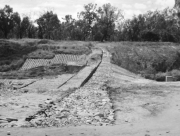
|
|
The design uses a clay embankment on the upstream side. The
embankment provides an impervious but flexible seal. Snow
Engstrom is watering the partially completed embankment to
achieve the necessary moisture content for compaction.
|
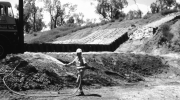
|
|
The core of the structure is comprised of rows of steel sheet
piling driven into the foundation. This maintains the
stability of the embankment. Jim Prosser is directing the
driving of piles.
|

|
|
The spaces between the rows of piles are filled with free
draining fill. The photograph is taken from upstream and shows
the most downstream rows of piles partially completed.
|

|
|
The free draining fill is covered with a layer of concreted
rockfill. The tiered arrangement of the piles and the rough
surface of the concreted rockfill provide for the dissipation
of the energy in water flowing over the weir. This limits the
length of downstream channel that must be protected against
scour. The workers are vibrating concrete into a section of
the rockfill.
|
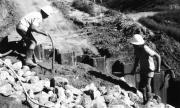
|
|
Bank and channel protection is provided by rockfilled gabions.
These are of two types. The first type, called
mattresses,
are used on mild slopes. The second type, called
sausages,
are used on steeper slopes. The photograph shows mattresses in
the foreground and sausages on the slope in the background.
The workers are stitching closed the wire mesh surrounding the
rockfill in one of the mattresses.
|
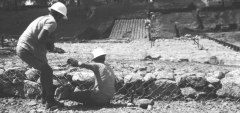
|
|
The boundary of the bank protection works is underlain by a
rockfill trench. The rockfill in the trench protects the
gabions from undermining.
|

|
|
The outlet works comprise a pipe connecting an inlet structure
and an outlet structure. The inlet structure is in the
reservoir at the upstream toe of the clay embankment. It has
trash racks to prevent the entry of large solid objects.
|
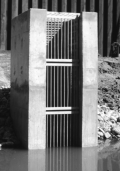
|
|
The outlet structure is in the downstream row of steel sheet
piles. It has a valve to control the flow of water through
the pipe.
|
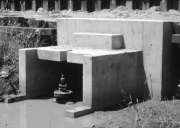
|
|
There is a bulkhead with a collar where the pipe passes through
a row of steel sheet piles.
|
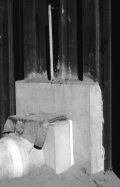
|
|
The rows of steel sheet piles are held in position by
galvanised steel tie rods ...
|

|
|
and treated hardwood walers. The walers are supported by
galvanised steel corbels. The rods are clamped to the walers
with nuts and washers.
|
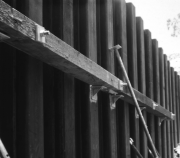
|
|
The rows of steel sheet piles have weep holes to allow the free
draining fill to drain.
|

|
|
On the upstream side, each weep hole has a reinforced concrete
housing with the hole filled with no fines concrete. The no
fines concrete allows the passage of seepage water while
retaining the fill.
|
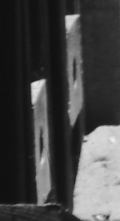
|
Images supplied by Jon Henry. Surely other Members can provide
images of structures more spectacular than Baralaba Anabranch Weir.














